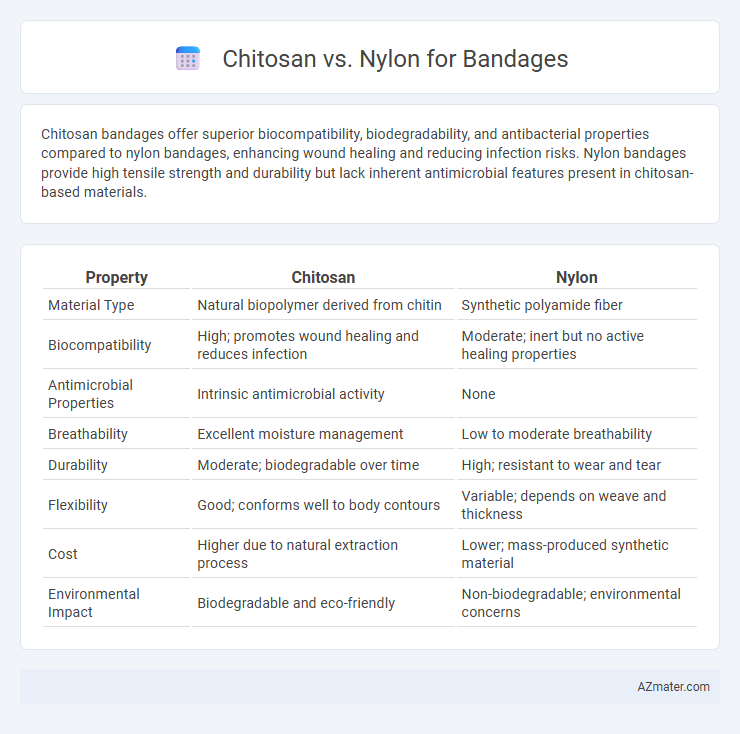Chitosan bandages offer superior biocompatibility, biodegradability, and antibacterial properties compared to nylon bandages, enhancing wound healing and reducing infection risks. Nylon bandages provide high tensile strength and durability but lack inherent antimicrobial features present in chitosan-based materials.
Table of Comparison
| Property | Chitosan | Nylon |
|---|---|---|
| Material Type | Natural biopolymer derived from chitin | Synthetic polyamide fiber |
| Biocompatibility | High; promotes wound healing and reduces infection | Moderate; inert but no active healing properties |
| Antimicrobial Properties | Intrinsic antimicrobial activity | None |
| Breathability | Excellent moisture management | Low to moderate breathability |
| Durability | Moderate; biodegradable over time | High; resistant to wear and tear |
| Flexibility | Good; conforms well to body contours | Variable; depends on weave and thickness |
| Cost | Higher due to natural extraction process | Lower; mass-produced synthetic material |
| Environmental Impact | Biodegradable and eco-friendly | Non-biodegradable; environmental concerns |
Introduction to Bandage Materials
Chitosan and nylon are prominent materials used in bandages due to their distinct properties suited for wound care. Chitosan, a natural biopolymer derived from chitin, offers excellent biocompatibility, antimicrobial action, and promotes faster wound healing. Nylon, a synthetic polymer, provides superior tensile strength, flexibility, and durability, making it ideal for supporting wound closure and protection.
Overview of Chitosan: Properties and Uses
Chitosan, a biopolymer derived from chitin found in crustacean shells, exhibits remarkable biocompatibility, biodegradability, and antimicrobial properties, making it highly suitable for medical applications such as wound dressings and bandages. Its inherent ability to promote hemostasis and accelerate tissue regeneration distinguishes chitosan-based bandages from synthetic counterparts like nylon, which lack these bioactive features. The versatility of chitosan extends to enhanced moisture retention and infection control, contributing to improved healing outcomes in advanced wound care.
Nylon Bandages: Features and Applications
Nylon bandages offer superior tensile strength, elasticity, and durability compared to other materials, making them ideal for securing dressings and providing consistent pressure on wounds. Their breathable fabric enhances patient comfort by allowing air circulation and moisture evaporation, reducing the risk of skin maceration. Commonly used in sports medicine and post-operative care, nylon bandages facilitate flexible movement while maintaining effective wound protection.
Biocompatibility: Chitosan vs Nylon
Chitosan exhibits superior biocompatibility compared to nylon, as it is a natural polysaccharide derived from chitin with inherent antimicrobial and wound-healing properties. Nylon, a synthetic polymer, can cause irritation or allergic reactions in sensitive skin, whereas chitosan promotes cell adhesion and accelerates tissue regeneration without eliciting significant immune responses. These biocompatible characteristics make chitosan an increasingly preferred material for advanced, infection-resistant bandages.
Absorbency and Moisture Control Comparison
Chitosan bandages demonstrate superior absorbency due to their natural polysaccharide structure, efficiently managing wound exudate and promoting a moist healing environment. Nylon bandages, while durable, lack the inherent moisture retention properties of chitosan and often require additional layers to control fluid effectively. The biocompatible and hydrophilic nature of chitosan enhances moisture control, reducing infection risk and accelerating tissue repair compared to nylon-based alternatives.
Antimicrobial Effectiveness of Chitosan and Nylon
Chitosan exhibits superior antimicrobial effectiveness compared to nylon due to its natural biopolymer structure that disrupts microbial cell membranes and inhibits bacterial growth, making it highly suitable for wound care applications. Nylon lacks inherent antimicrobial properties and often requires chemical treatments to achieve similar effects, which can limit its biocompatibility and safety. Studies demonstrate that chitosan-based bandages reduce infection rates significantly better than nylon alternatives, promoting faster healing and improved patient outcomes.
Strength and Durability: Nylon vs Chitosan
Nylon bandages exhibit superior tensile strength and durability compared to chitosan, making them more resistant to tearing and wear during extended use. Chitosan bandages offer moderate strength but excel in biodegradability and antimicrobial properties, which enhance wound healing despite lower mechanical resilience. The choice between nylon and chitosan depends on prioritizing durability versus bioactivity in wound care applications.
Ease of Application and User Comfort
Chitosan bandages offer superior ease of application due to their natural adhesive properties, allowing for quick and secure wound coverage without the need for additional adhesives. Nylon bandages, while durable, often require precise placement and can cause discomfort due to stiffness and lower breathability. The biocompatibility and flexibility of chitosan enhance user comfort by reducing skin irritation and promoting faster healing compared to traditional nylon materials.
Environmental Impact and Biodegradability
Chitosan bandages offer significant environmental benefits due to their natural origin and complete biodegradability, reducing landfill waste and minimizing pollution. In contrast, nylon bandages are synthetic polymers with limited biodegradability, contributing to persistent plastic waste and environmental accumulation. Choosing chitosan over nylon enhances sustainability efforts by supporting eco-friendly medical waste management and promoting faster environmental decomposition.
Choosing the Right Bandage Material: Chitosan or Nylon
Chitosan bandages offer superior biocompatibility and promote faster wound healing due to their antimicrobial properties and ability to accelerate blood clotting. Nylon bandages provide excellent durability and elasticity, making them ideal for flexible areas but lack the inherent bioactivity of chitosan. Selecting the right bandage material depends on the wound type and healing requirements, with chitosan preferred for infection control and tissue regeneration, while nylon suits mechanical protection and support.

Infographic: Chitosan vs Nylon for Bandage
 azmater.com
azmater.com